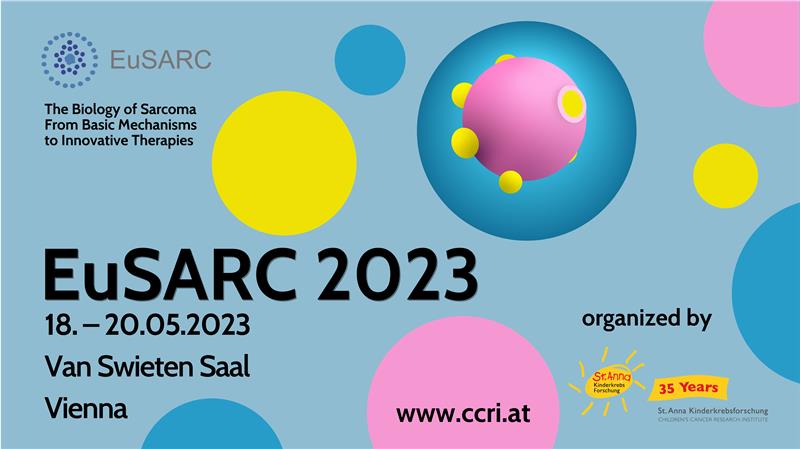International sarcoma meeting “EuSARC” hosted by
St. Anna CCRI in Vienna

(Vienna, 16.5.2023) From May 18th to 20th, St. Anna Children’s Cancer Research Institute (St. Anna CCRI) welcomes scientists and physicians from Europe, the USA, and beyond, at the EuSARC 2023 meeting in Vienna. EuSARC is a Europe-wide group of scientists holding annual meetings to address the dire need for novel therapies in sarcomas, a group of poorly explored bone and soft tissue tumors.
Sarcomas account for 2% of all cancers and are among the least studied cancer types. “Given the fact that they are rare, they get less attention, which makes meetings like EuSARC so important. EuSARC intends to improve communication among scientists and clinicians that share the passion for research in sarcomas affecting children, adolescents and adults. We are eager to learn from every patient and bridge the gap between basic and clinical research in order to develop new therapies”, says Eleni Tomazou, PhD, a Principal Investigator at St. Anna CCRI, who is part of the EuSARC Scientific Committee.
“We are honored to have this important international meeting here in Vienna”, adds Prof. Kaan Boztug, MD, Scientific Director of St. Anna CCRI. “Pediatric sarcomas are understudied and deadly cancers, with limited new therapies and very little improvement of patient outcomes. Bringing the best scientists together and fostering international collaboration is crucial in order to discuss new findings and how to move forward.”
Potential new target for Ewing sarcoma
Among the invited speakers is Prof. Kimberly Stegmaier, MD, a leading expert in childhood cancer research at Dana-Farber Cancer Institute and Professor of Pediatrics at Harvard Medical School, Boston, USA. In her talk Kim Stegmaier will focus on new discoveries related to Ewing sarcoma, the second most common tumor involving bone in children and adolescents. “This tumor is driven by a fusion oncoprotein, most commonly the EWS-FLI1 fusion, which has proven to be a difficult drug target. From our studies, we have learned that Ewing sarcoma tumors require a precise amount of the EWS-FLI1 fusion, a so-called “Goldilocks” phenomenon. Too little or too much of the fusion is deleterious to the Ewing sarcoma cells”, explains Kim Stegmaier, who will discuss these findings and strategies toward the development of new therapies in her presentation at EuSARC.
Eleni Tomazou comments on the abovementioned findings, ”Together with her team, Kim Stegmaier has identified a protein called TRIM8 that regulates the amount of the EWS-FLI1 fusion protein in the cancer cell. Since the tumor cells rely on the precise regulation of the EWS-FLI1 amount, TRIM8 is an exciting new option to specifically target Ewing sarcoma.”
The program features talks from several renowned international experts, such as Silvia Stacchiotti, MD, Fondazione IRCCS Istituto Nazionale Tumori, Italy, who will outline new treatments for ultra-rare sarcomas, and Isidro Cortés-Ciriano, PhD, from EMBL’s European Bioinformatics Institute, UK, presenting new findings focusing on malignant peripheral nerve sheath tumor (MPNST), an aggressive soft-tissue sarcoma.
Meeting outside the box
“With the intent to drive innovation, we also invited top class guest speakers not directly linked to sarcoma. Dr. Georg Winter from CeMM for instance, is one of the pioneers in protein degradation. This novel technology may be of use for Ewing sarcoma, if you think of targeting its oncoprotein by degradation”, Kaan Boztug points out.
In total, the program includes 18 oral presentations and 40 flash talks. The best oral presentation and flash talk will be awarded at the end of the meeting, thanks to funding from the Bone Cancer Research Trust (UK). When asked what she is excited about the most, Eleni Tomazou refers to the chance to approach people and exchange ideas. “This is the first meeting without restrictions due to COVID. I am very much looking forward to seeing all my colleagues and friends. We benefit a lot from this personal interaction, also in terms of potential future collaborations and the discussion of new findings.”
Kim Stegmaier also highlights the benefit of meeting in person, “The pediatric sarcoma community is a wonderfully collaborative one. I have enjoyed interacting with St. Anna CCRI research leaders in many contexts, such as international meetings, pediatric cancer foundation sponsored think tanks, and as collaborators on research projects. Connections made in 2008 have led to 15 years of scientific synergy and friendship. I am certain that the upcoming EuSARC Congress will spark new collaborations too!”
Find the EuSARC 2023 program here: https://ccri.at/eusarc-23-program/
—
About EuSARC
The EuSARC 2023 meeting takes place in Vienna and covers multi-disciplinary topics from molecular mechanisms to novel therapies in pediatric and adult sarcomas. EuSARC is a Europe-wide group of dedicated scientists and clinicians holding regular meetings to bridge the gap between basic and clinical research on sarcomas. By organizing annual meetings, EuSARC aims to raise awareness of the dire need for novel research approaches to tackle these poorly explored tumors. After Prof. Nicola Baldini, MD, Prof. Dominique Heymann, PhD, and Prof. Thomas Grünewald, MD, PhD, organized the first meeting in Bologna, Italy, in 2018, EuSARC was hosted by different institutions around Europe to be as inclusive as possible. St. Anna Children’s Cancer Research Institute is closely linked to the EuSARC community and more than proud to be selected to host this year’s meeting at the van Swieten Saal Vienna.
About sarcomas
Sarcomas are malignant tumors of bones and soft tissue – a heterogeneous group that collectively accounts for approximately 2% of all cancers. They are among the least studied cancer types and have seen little therapeutic progress. Fresh ideas and initiatives are needed to address the unmet medical need of these hard-to-treat tumors.
Ewing sarcoma is a very aggressive tumor that occurs primarily in children and adolescents. With risk-adapted, multimodal therapy the 3-year survival rate is between 50 and 80%. Current chemotherapies have considerable side effects that impair the quality of life in the long term and potentially cause secondary malignancies. Nevertheless, they unfortunately do not help all patients.
Press Release: